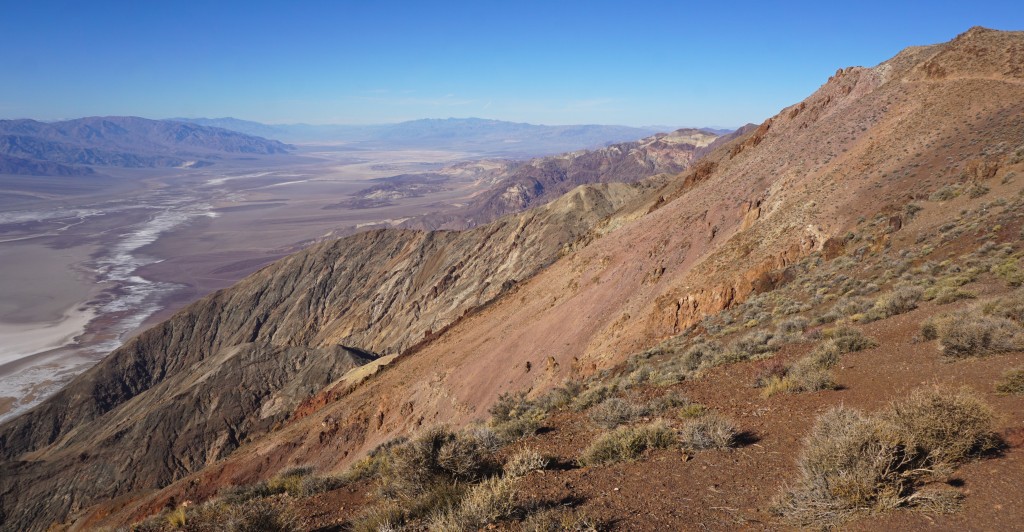I woke up this morning, the day of the presidential inauguration, hoping to stretch my legs and mind on a sunrise hike. Instead, rain fell – is still falling – from an opaque, grey sky, perhaps an ominous sign if not for the deep thirst of our drought-ridden ground here in California.
No mind, then. Instead, I thought back to a sunrise I experienced last week while in Death Valley National Park. My friend Brooke and I rose in the early morning dark, a brisk wind beating us awake through the walls of the tent. We communicated in sleepy mumbles while tying on shoes and zipping up coats, then headed out to Zabriskie Point, an overlook above an impressive stretch of deeply folded badlands. We’d hiked a loop just below the day before, between Golden Canyon and neighboring Gower Gulch, marveling at the mineral striations decorating the canyon walls, the lavender rocks underfoot, the mark of wind and water all around. This particular morning, the colors glowed softly at first, then with more vibrancy as the dusky pre-dawn became illuminated. It was stunning and peaceful all at once.
If you’re not careful, Death Valley is the kind of place you’ll fall in love with before you realize it, maybe without even wanting it to happen. You’ll be drawn in by the otherworldly geometry, the shocking array of colors, and how in contrast to its name, the place pulses with life in unexpected ways. You’ll stand at an overlook to gain sweeping views to the salt flat below and snow-capped peaks above, only to realize the massive viewshed is nothing more than a fraction of these boundless lands. You’ll scamper along on sand dunes, cresting one ridge only to discover a feeling of infinity beyond. You’ll find yourself a tiny speck in relation, experiencing a graceful humility beyond all else.
Brooke had never been to Death Valley before, and she spent those three days on a continual wonder trip, her exclamations careening on a loop between describing the place as “vast” and “beautiful,” both things so very true. It was a gift to share this magical place with her, and it’s a gift to all of us that it is protected as a national park.
Most people probably don’t know the history of Death Valley – or any of our national parks, for that matter – and most probably don’t realize that a large chunk of our public lands exist because of the Antiquities Act of 1906, passed by Theodore Roosevelt to allow presidential oversight in protecting places with important cultural, historic, and scientific significance. During his time in office, he made eighteen designations, including Devils Tower in Wyoming, Lassen Peak in California, and a little something called the Grand Canyon.
Death Valley was designated by Herbert Hoover as a National Monument in 1933, one of nineteen places he protected during his term in office. Hoover grew up with a deep love of and respect for the land, along with a belief in the healing power of nature. He communicated that during his term: these places were not set aside for gas, mineral, or oil extraction, but for the greater good, to preserve not just their cultural and natural resources, but also their effect on humanity. On our very humanness.
The monument became Death Valley National Park in 1994, part of the preservations set forth under the Clinton-endorsed Desert Protection Act, which also saw the establishment of Joshua Tree National Park and Mojave National Preserve. Because of the foresight of Presidents Roosevelt, Hoover, and Clinton, and because of the commitment of California Senators Alan Cranston and Dianne Feinstein, multiple regional organizations, and concerned citizens, we can escape to these protected places to find wonder and joy, seek solace and space, and experience a pure relationship with the land.
However, I think every outdoorsperson – from hiker to hunter, cyclist to boater, takes for granted that other people share the same enthusiasm for unspoiled spaces, and that our government representatives will continue to think beyond the here and now to protect and preserve for generations to come. We can no longer assume this. Certainly, Republican members of Congress and the incoming administration have already promised an assault on not only the Antiquities Act, but also on the continued preservation of public lands. In fact, the new administration has already teased plans on Day One to derail policies like the Climate Action Plan in favor of pursuing more aggressive resource extraction: “We must take advantage of the estimated $50 trillion in untapped shale, oil, and natural gas reserves, especially those on federal lands that the American people own.”
Well, they said it – WE own these lands.
It’s important for all of us who love our national parks, monuments, and other public lands to not only get out there and enjoy them, but also prepare to defend them. Learn about your local and state officials’ stance on land management, natural resource management, renewable energy, and climate change (try here or here) – and let them know how you feel about it. Get involved with local organizations and community efforts related to public lands and other environmental issues. Donate to national organizations like the Trust for Public Land and the Sierra Club, who are actively working on these fronts.
Most importantly, perhaps, take other people outside and let them find the magic and build their own connection to these special places, so that they, too, may become stewards of the land.




















